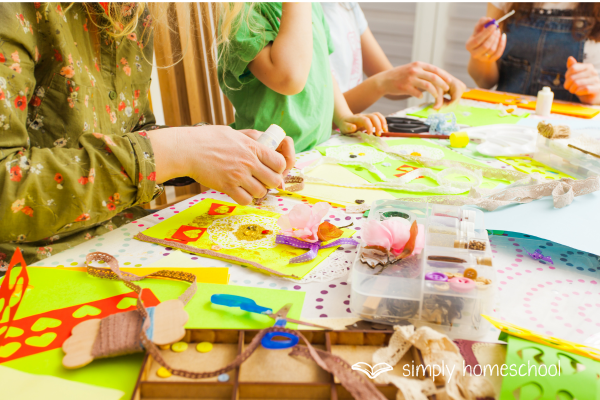Homeschool Time Management
How to balance learning, housework, and life without burning out

Homeschooling is a beautiful journey. But let’s be honest, it can also feel like juggling flaming torches while riding a unicycle. Between teaching multiple subjects, managing meals, keeping the house in order, and finding a moment to breathe, time management quickly becomes one of the most important (and challenging!) skills for homeschool families.
The good news is that you don’t need to run your home like a rigid school or live by the stopwatch to make it work. You can build a rhythm that supports learning, reduces stress, and fits your unique family.
Here’s how to make it happen.

Set realistic goals for your day and week
One of the most common mistakes new homeschoolers make is over-planning. Your homeschool day doesn’t have to mirror a full six-hour school day.
Instead, focus on quality over quantity. A few hours of focused learning at a time when your children are most engaged is often more effective than an entire day of distracted instruction.
Try this:
- Choose a couple of Core Programs or subjects to focus on each day – perhaps maths, reading and writing.
- Break the rest of your Core Programs or activities into weekly rotations.
- Use a ‘Must Do / Nice to Do’ list to manage expectations and give yourself flexibility.
- Remember, it’s okay if sometimes you don’t get time for everything, or if everyone in the family doesn’t feel like working on the activities at that time. That’s the beauty of homeschooling. A morning spent at the beach or with friends is just as valuable!

Create a flexible, predictable routine
Kids thrive on routine, and so do adults. But the beauty of homeschooling is that your routine doesn’t have to be strict. Think rhythm over rigidity.
Here’s a sample daily structure for young kids:
- Morning: Maths, reading and play
- Midday: Outdoor play and lunch
- Afternoon: Interest-based Core Program and play
- Evening: Family reading or game time
And for teens:
- Morning: Maths, independent work on Core activities, interest-based reading
- Midday: Time outside recharging (going for a walk, shooting some hoops, scooting, whatever their body needs) and lunch
- Afternoon: Interest-based Core Program and time working on personal projects
- Evening: Family reading or game time
A predictable flow helps everyone know what to expect, even if the exact timing shifts.
Tip: A visual schedule or planner on the wall can help younger kids stay engaged and on track. We have created a simple one for you here.

Use time blocks or anchor points
Rather than trying to follow a minute-by-minute schedule (which almost always breaks down), try time blocking or anchor-based routines.
- Time blocking means assigning broad chunks of the day to types of activities, like:
- Morning Block: School work
- Mid-day Block: Read aloud and play
- Afternoon Block: Chores and quiet time
- Anchors tie activities to recurring events. For example:
- After breakfast, we read.
- After lunch, it's outdoor time.
These methods offer structure without micromanaging every moment – perfect for homeschooling.
Rotate between independent and group learning
If you're homeschooling multiple kids, this is your secret weapon.
While one child does:
- an online lesson
- a Core activity, or
- reading time,
…you can work one-on-one with another child. Then switch.
Work checklists give kids a sense of ownership and help you manage your time efficiently without constantly bouncing between children. A checklist can be as simple as a list of tasks each child can complete independently. For young children and pre-readers, pictures of tasks work well.

Plan ahead, but stay flexible
Planning your week can save you from daily decision fatigue. A weekly planning session on Sunday evening (or whatever day works best for you) can make a huge difference.
Here’s a simple format:
- Review what you completed last week. Make a note of anything you need to go over or would like to explore this week.
- Set goals for the week. Read through Core activities, check that you have everything you need and print anything that’s likely to come up next week.
- Pencil in other activities like museum visits and excursions.
- Leave space for the unexpected.
At the end of the week, reflect: What worked? What needs to change? Homeschooling is a living process. Don’t be afraid to adapt.
Leave room for margin
Over-scheduling leads straight to burnout for you and your kids. Build in margin every day:
- A break between subjects/Cores
- A quiet time block in the afternoon
- A ‘no formal school’ Friday now and then
Rest and unstructured time are not wasted. They are where creativity, processing, and restoration happen.

Get the whole family involved
Homeschooling works best as a team effort. Chores, lunch prep, and even planning can be shared. Consider:
- Assigning age-appropriate chores. Clean-up is part of life skills.
- Letting older kids assist younger siblings with reading or projects.
- Holding short weekly family meetings to talk about what’s working and what’s not. Add some delicious treats to keep the mood light and positive.
This builds responsibility, lightens your load, and strengthens family bonds.
Use tools to stay organised
Whether you like digital or are a classic paper and pen kind of person, having a way to organise and stay on top of your homeschool will go a long way towards reducing feelings of overwhelm and burnout.
Using a paper or digital planner or recording completed Core activities in your Family Learning Plan are simple ways to keep track of each child’s learning, as well as helping you to see new interests developing and the progress they are making.
It also means, if ever you’re feeling like you’re not doing enough, you can look back and reassure yourself that, yes, in fact, you are doing more than enough.

Final thoughts: progress, not perfection
Some days, you’ll feel on top of the world. Other days, you’ll forget what you were teaching mid-sentence – and that’s okay.
Time management in a homeschool household isn’t about having perfect control. It’s about building a rhythm that supports learning and living. Give yourself grace. Adjust when needed. And celebrate the small wins, because they’re adding up more than you think.
